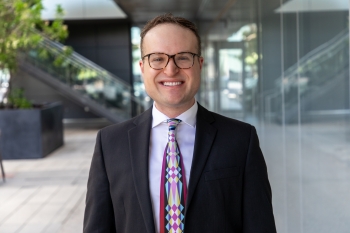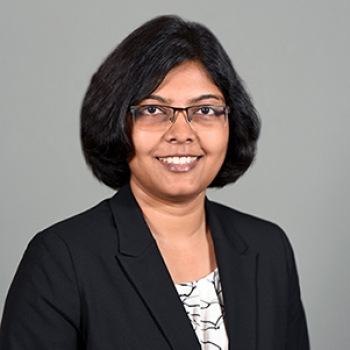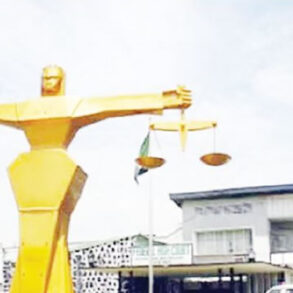The law is global, touching every person in every country in some way, shape or form.
It’s a fact that Alexander Mallory knows well. The alum of the Sandra Day O’Connor College of Law at Arizona State University (’19 JD) will head to Luxembourg this fall as a stagiaire, or clerk, for the European Court of Justice with Judge Paul Nihoul.

Sandra Day O’Connor College of Law at Arizona State University alum Alexander Mallory. Courtesy photo
Download Full Image
The position is part of the Dean Acheson Legal Stage Program, organized by the U.S. Embassy in Luxembourg and created to foster mutual understanding between the U.S. and the European Union in the area of law.
There are 27 slots each fall and spring and only two or three American applicants are selected for the honor each term.
“Alexander is a rising star in the Native American legal community. As a Native lawyer with a breadth of experience in tribal, immigration, civil and criminal contexts, he will bring a unique perspective to this international opportunity,” said Patty Ferguson-Bohnee, faculty director of the Indian Legal Program at ASU Law and associate dean for inclusive excellence.
It’s not Mallory’s first experience with the legal system in a foreign country. Mallory, a graduate of the Indian Legal Program and an enrolled member in the Winnebago Tribe of Nebraska, also participated in the school’s exchange program with Universita Bocconi School of Law in Milan, Italy, during his time in law school.
“Having lived and studied abroad before, it showed me that the law is a global endeavor,” he said. “As citizens of the U.S., we hold such a privileged perspective in that the rest of the world looks to us for guidance on the rule of law. It’s powerful to see that in the international arena.”
In addition to the exchange program and his participation in the Indian Legal Program, which is celebrating its 35th anniversary this year, Mallory also lived and worked in the nation’s capital through ASU Law’s Washington, D.C., program. He also completed an externship with the Maui Public Defender’s Office and a clerkship with the Honorable Daniel H. Weiss at the U.S. Immigration Court through the U.S. Department of Justice Honors Program.
Currently, he is a judicial law clerk for the Honorable Diane J. Humetewa at the U.S. District Court for the District of Arizona, another ASU Law alum (’93 JD), who is an enrolled member of the Hopi Tribe and the first Native American woman to serve as a federal judge. Mallory is also a longstanding member of the Pre-Law Summer Institute’s Judicial Clerkship Committee, a group dedicated to increasing the number of Native clerks in the judiciary. He said his time at ASU Law prepared him for the prestigious and competitive clerkship he’s about to take on.
“Alexander’s inquisitiveness about legal systems and their impacts on people, globally, makes him well suited for this next challenge,” Humetewa said. “His vast experience working in a variety of judicial systems, including the U.S. Federal Courts, will serve the European Court well.”
Mallory said his path to law school and everything he’s achieved since was inspired by his Cōka, or grandfather, Kenny Mallory, who worked in public service nearly his whole life.
“He served on the Winnebago Tribal Council for over two decades,” he said. “Following in his footsteps has been one of life’s greatest blessings. He showed me that the government — and particularly the law — can be a force for good if harnessed properly.”
That inspiration will lead him to Luxembourg this September, where he will live and work through December. There, he’ll take in the sights and get to work for Nihoul, assisting him with his decisions and primarily looking at EU legal issues, including antitrust issues and conflicts between member states. He looks forward to representing ASU Law and ILP abroad.
“I am a firm believer in using the law to build bridges between contrasting cultures,” he said. “It’s a privilege I don’t take for granted.”

Solar, wind and hydropower are among the most common sources of renewable energy, which can be replenished at higher rates and create lower emissions than fossil fuels.
A unique method of generating energy is through photocatalytic water-splitting, a chemical reaction in which sunlight is used to break water down into hydrogen and oxygen.

Arunima Singh
Download Full Image
Arunima Singh, an assistant professor in the Department of Physics at Arizona State University, received an Early Career Research Program grant from the United States Department of Energy to aid her research on efficient ways to conduct the water-splitting process.
Converting water into hydrogen and oxygen gas is a non-spontaneous process, and a catalyst is needed to enable the conversion. Singh plans to employ quantum mechanical simulations and physics-based machine learning models for the data-driven discovery of water-splitting photocatalytic heterostructures.
Her study will consider thousands of heterostructures of catalytic two-dimensional materials and record-breaking sunlight absorber bulk materials, such as silicon, gallium arsenide or cadmium telluride.
She uses supercomputers to run first-principles quantum mechanical simulations to investigate the interaction between 2D materials and bulk materials.
This provides many advantages over conducting lab experiments. However, the most important advantage is time.
Testing the suitability of one heterostructure for photocatalysis would take a year or more in a lab. With computer simulations, the properties of one heterostructure can be predicted within 24–48 hours.
“Dr. Singh excels in the discovery and design of materials for energy conversion and nanoelectronics applications, and is making transformative advances in several areas. Her research methods draw concepts from quantum physics, data science and machine learning, and develop novel approaches, algorithms and software tools that enable long-term and impactful expansion of science and technology boundaries,” said Patricia Rankin, chair of the Department of Physics at ASU.
The grant from the Department of Energy will keep Singh’s research going for at least the next five years as they continue to test over 50,000 heterostructures.
“We are grateful to the DOE for this funding. There’s a lot of scientific questions we can answer, a lot of progress to be made,” she said. “Without it, we wouldn’t have the funding for the talented graduate and postdoc students who move this work forward.”

This post was originally published on this site be sure to check out more of their content.




